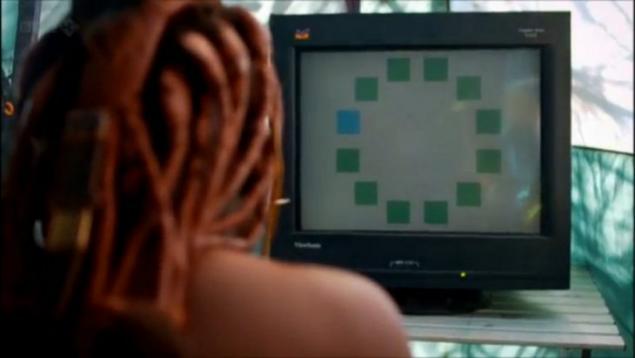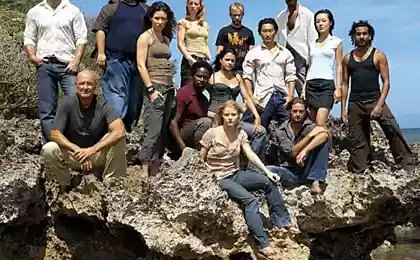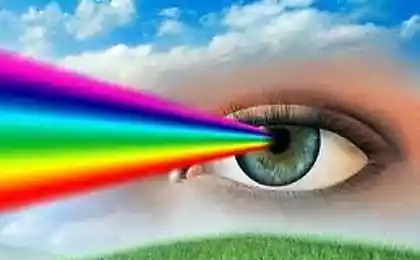752
Until recently in human history, the blue color did not exist!
Talk about how people see the world and how, without the ability to describe, even something so fundamental as a color, we don't notice that it exists. Until relatively recently in human history the "blue" color didn't exist. In the ancient languages did not have words to describe the blue — neither in Greek nor Chinese, nor Japanese, nor in the Hebrew. There is evidence that not having the words to describe this color, people do not see.

Cameralabs.orgWebsite published a translation of a fascinating article publication BusinessInsider.
As we understand that blue is not enough "the Odyssey" Homer compares the sea with the color "dark wine." But why "dark wine", not dark blue or green?
In 1858, a scientist named William Gladstone, who later became Prime Minister of great Britain, noticed that this is not the only strange description of the colors. Poet page after page described the intricate details of clothing, armor, weapons, facial features, animals and more. But his mention of the colours is very unusual. Iron sheep violet; honey green.
Gladstone decided to count the number of references of each colour in the book. It turned out that black can be found almost 200 times; white is about 100; the other colors are much rarer. Red at least 15 times, and the yellow and green is less than 10. Gladstone turned to the other ancient Greek texts and found the same thing — never mentioned blue. This word did not even exist.
It seemed that the Greeks lived in sullen and gloomy world devoid of bright colors, with a predominance of black, white and metal colors, with occasional splashes of red or yellow.
Gladstone decided that this was a unique perception only of the ancient Greeks. However, his ideas were developed by the German philologist and philosopher Lazarus Geiger (Geiger Lazarus), who in his writings noted that something similar was observed in different cultures.
He studied the Icelandic sagas, the Koran, ancient Chinese history and the Hebrew version of the Bible. The Hindu Vedic hymns, Geiger wrote: "In these labors, more than ten thousand lines abound with descriptions of heaven. There is hardly an object is described more. The sun, blazing sunrises, day and night, cloud and lightning, air and ether — all of this is revealed to us again and again... but there's something no one would ever learn from those ancient songs. That the sky is blue".
Blue was not, is not distinguished from the green or dark shades.
Geiger tracked when foreign languages began to appear "blue" and revealed an interesting picture.
Each language in the first place the words appeared to refer to black and white or dark and light. The next word that arose to describe the colors in each target language around the world — red, the color of blood and wine.
Next came yellow, then green (in several languages yellow and green are swapped). The last of these flowers in every language appeared blue.
The only ancient people who used the word to describe blue is the Egyptians. And as a result, it is the only culture that produced a blue dye.
If you think about blue in nature so much — there is almost no animal that color, blue eyes are rare, and the blue flowers are mostly bred by people. Of course, there is the sky, blue but does it really? As we have seen from the works of Geiger, even in the texts that abound with descriptions of the sky is not necessarily blue.
Whether the sky is blue? Researcher guy Deutscher (Guy Deutscher), bestselling author of "Through the mirror of language: why in other languages, the world looks different", held an informal experiment. As you know, one of the first children's questions that parents hear: "Why is the sky blue?" Deutscher was raising his daughter, trying to describe the color of the sky, and one day asked her what color she sees over his head. Alma, daughter deucher, had not the slightest idea. For her the sky was colorless. At first, the girl decided that it whiteand then finally blue. But the color blue was not the first one she called.
It turns out, people didn't see the blue color until there was a word to describe it?
It is difficult to understand, because we don't know exactly what was going on in the mind of Homer when he described the sea the color of dark wine and purple sheep. But we know that the Greeks and other peoples of the ancient world from a biological point of view possessed the same ability to see colors that we do.
Can we see something for which we have no words?
To answer this question the researcher Jules Davidoff (Jules Davidoff) went to Namibia. There he conducted an experiment in the himba tribe, which speaks a language that does not have definitions for blue and do not distinguish blue from green.
When the tribe people showed a circle with 11 green squares and one blue, they are unable to choose which one was different from the rest. And those who saw a difference, has spent some time and made a few mistakes before I pointed to a blue square.
But in the himba language has more words to describe shades of green, for example, than in English.
Looking at the circle with the green squares, one of which is a slightly different hue, they immediately notice the difference. And you can?

Cameralabs.addblist of us struggling to cope with this task.
Here it is, the exclusive square:

Cameralabs.oddveig came to the conclusion that not having words to define the color, in the absence of the method of its recognition, it is much harder to notice its uniqueness. Even if our eyes can physically perceive it, we have color somehow blocked.
It turns out that before the blue color is common, maybe people saw it, but I guess they didn't know about it.
Is it possible that the colors are manifest in our lives over time? Not technically, but our ability to distinguish between them. If we can't see something, does it exist in reality?
via www.businessinsider.com/what-is-blue-and-how-do-we-see-color-2015-2

Cameralabs.orgWebsite published a translation of a fascinating article publication BusinessInsider.
As we understand that blue is not enough "the Odyssey" Homer compares the sea with the color "dark wine." But why "dark wine", not dark blue or green?
In 1858, a scientist named William Gladstone, who later became Prime Minister of great Britain, noticed that this is not the only strange description of the colors. Poet page after page described the intricate details of clothing, armor, weapons, facial features, animals and more. But his mention of the colours is very unusual. Iron sheep violet; honey green.
Gladstone decided to count the number of references of each colour in the book. It turned out that black can be found almost 200 times; white is about 100; the other colors are much rarer. Red at least 15 times, and the yellow and green is less than 10. Gladstone turned to the other ancient Greek texts and found the same thing — never mentioned blue. This word did not even exist.
It seemed that the Greeks lived in sullen and gloomy world devoid of bright colors, with a predominance of black, white and metal colors, with occasional splashes of red or yellow.
Gladstone decided that this was a unique perception only of the ancient Greeks. However, his ideas were developed by the German philologist and philosopher Lazarus Geiger (Geiger Lazarus), who in his writings noted that something similar was observed in different cultures.
He studied the Icelandic sagas, the Koran, ancient Chinese history and the Hebrew version of the Bible. The Hindu Vedic hymns, Geiger wrote: "In these labors, more than ten thousand lines abound with descriptions of heaven. There is hardly an object is described more. The sun, blazing sunrises, day and night, cloud and lightning, air and ether — all of this is revealed to us again and again... but there's something no one would ever learn from those ancient songs. That the sky is blue".
Blue was not, is not distinguished from the green or dark shades.
Geiger tracked when foreign languages began to appear "blue" and revealed an interesting picture.
Each language in the first place the words appeared to refer to black and white or dark and light. The next word that arose to describe the colors in each target language around the world — red, the color of blood and wine.
Next came yellow, then green (in several languages yellow and green are swapped). The last of these flowers in every language appeared blue.
The only ancient people who used the word to describe blue is the Egyptians. And as a result, it is the only culture that produced a blue dye.
If you think about blue in nature so much — there is almost no animal that color, blue eyes are rare, and the blue flowers are mostly bred by people. Of course, there is the sky, blue but does it really? As we have seen from the works of Geiger, even in the texts that abound with descriptions of the sky is not necessarily blue.
Whether the sky is blue? Researcher guy Deutscher (Guy Deutscher), bestselling author of "Through the mirror of language: why in other languages, the world looks different", held an informal experiment. As you know, one of the first children's questions that parents hear: "Why is the sky blue?" Deutscher was raising his daughter, trying to describe the color of the sky, and one day asked her what color she sees over his head. Alma, daughter deucher, had not the slightest idea. For her the sky was colorless. At first, the girl decided that it whiteand then finally blue. But the color blue was not the first one she called.
It turns out, people didn't see the blue color until there was a word to describe it?
It is difficult to understand, because we don't know exactly what was going on in the mind of Homer when he described the sea the color of dark wine and purple sheep. But we know that the Greeks and other peoples of the ancient world from a biological point of view possessed the same ability to see colors that we do.
Can we see something for which we have no words?
To answer this question the researcher Jules Davidoff (Jules Davidoff) went to Namibia. There he conducted an experiment in the himba tribe, which speaks a language that does not have definitions for blue and do not distinguish blue from green.
When the tribe people showed a circle with 11 green squares and one blue, they are unable to choose which one was different from the rest. And those who saw a difference, has spent some time and made a few mistakes before I pointed to a blue square.
But in the himba language has more words to describe shades of green, for example, than in English.
Looking at the circle with the green squares, one of which is a slightly different hue, they immediately notice the difference. And you can?

Cameralabs.addblist of us struggling to cope with this task.
Here it is, the exclusive square:

Cameralabs.oddveig came to the conclusion that not having words to define the color, in the absence of the method of its recognition, it is much harder to notice its uniqueness. Even if our eyes can physically perceive it, we have color somehow blocked.
It turns out that before the blue color is common, maybe people saw it, but I guess they didn't know about it.
Is it possible that the colors are manifest in our lives over time? Not technically, but our ability to distinguish between them. If we can't see something, does it exist in reality?
via www.businessinsider.com/what-is-blue-and-how-do-we-see-color-2015-2
The Russian Empire in color: photography 34, which for over a hundred years
Indian businessman gave his employees 1260 machines and 400 apartments























